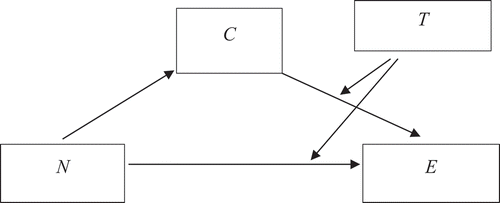Figures & data
Table 1. Expectations based on country scores in Hofstede (Citation2001, Citationn.d.) for cultural orientation per nationality and per cultural dimension (scale from 0 to 100).
Table 2. Mean scores and standard deviations for cultural orientation variables (scale from 1 to 7) for participants from The Netherlands, China, and South Africa.
Table 3. Results found for cultural orientation compared to expectations based on country scores in Hofstede (Citation2001, Citationn.d.).
Table 4. Mean scores and standard deviations for EPPM-related variables (minimum 1, maximum 7) for participants from the Netherlands, China, and South Africa for text A (target of threat: self) and text B (target of threat: family).
Figure 1. Conditional direct effect of N on E, and conditional indirect effect of N on E through C (see Hayes, Citation2013, p. 451, moderated mediation model 15). N = Nationality (independent variable): Dutch versus Chinese, Dutch versus South African, or Chinese versus South African; C = Cultural orientation variables (mediators): individualism-collectivism, femininity-masculinity, power distance, uncertainty avoidance, short term versus long term orientation, self-referenced familism, and culture-referenced familism; T = Text version (moderator): self-targeted versus family-targeted; E = EPPM variables (dependent variables): perceived severity, perceived susceptibility, or danger control.

